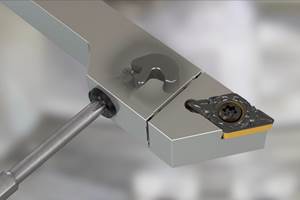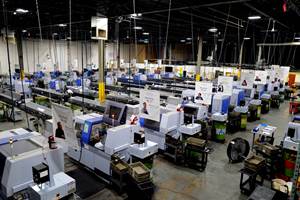Vertical Turning Debut Boosts Productivity In Aerospace Application
Thomson Machine & Tool (Somerset, England) required a large-capacity turning center for machining aerospace components with diameters of up to 2,000 mm, in a range of materials including titanium and nimonic alloys.
Share






Thomson Machine & Tool (Somerset, England) required a large-capacity turning center for machining aerospace components with diameters of up to 2,000 mm, in a range of materials including titanium and nimonic alloys. Although this operation had previously been performed using a traditional horizontal lathe, the nature of the application suggested that a switch to vertical turning would provide advantages leading to significant improvements in productivity.
"After considering a number of options, we decided that a vertical turning center offered the right combination of capacity, rigidity and versatility for this application," explains Thomson Machine & Tool's managing director, Allan Thomson. "We chose a Webster & Bennett (Coventry, England) machine because of the company's expertise in vertical turning, coupled with the unrivalled reputation for performance and build quality enjoyed by its products."
Webster & Bennett supplied Thomson Machine & Tool with a two-axis vertical turning center with 72-inch table and 8-inch square ram, suited to machining large cylindrical components thanks to a maximum height under the cross rail of 57.5 inches, a ram stroke of 48 inches and maximum swing of 84 inches. The machine incorporates a range of features designed to maximize productivity while maintaining the quality of the components being machined.
With a maximum load capacity of 11,363 kg, large and heavy components can be supported on the machine's table and held in place using Webster & Bennett's four-jaw independent chuck, a setup that eliminates inaccuracies associated with the effect of gravity on horizontally clamped components. This inherent advantage of vertical turning, complemented by the inclusion of a Timken table bearing and ballscrews on the X and Z axis, has enabled Thomson Machine & Tool to achieve levels of machining accuracy and consistency that they could not match using horizontal lathes. Operators at the company have also noticed a significant improvement in the surface finish of components manufactured on the Webster & Bennett machine.
"Every aspect of the vertical turning center's design and construction contributes to its overall rigidity, resulting in a superior machining performance, which is reflected in the quality of the components we produce," says Mr. Thomson.
The machine's 18-station automatic tool changer enables multiple machining operations to be performed in a single setup. This is crucial in the manufacture of large and awkward components at Thomson Machine & Tool, and this benefit has contributed to a typical reduction in product cycle times of 20 percent. Another significant benefit of this versatility is the scope for product diversification it has provided. "The machine's ability to perform a wide range of machining operations quickly and efficiently has helped us to reduce throughput times while increasing our scope for diversification into new products and markets," Mr. Thomson explains.
Optimum metal removal is assured by the machine's wide speed range of 5-167 rpm, provided by a two-speed gearbox and 37.5 kw main drive motor, specified by the customer in order to provide the low-speed, high-torque machining required for the successful production of aero engine components. CNC controlled servodrives add to the machine's operational speed and ease of use and contribute to the consistency of its machining accuracy.
Another factor in the vertical turning center's overall appeal has been its trouble-free integration into manufacturing operations at Thomson, made possible by a combination of the machine's easy-to-learn Fanuc 18Ti CNC control system and integral swarf conveyor with coolant system. Mr. Thomson also drew attention to the high level of technical support provided by Webster & Bennett, which enabled the installation of the machine with minimal disruption to Thomson Machine & Tool's manufacturing operations.
Full working area guarding and ease of use have also played a part in the machine's popularity among operators at Thomson Machine & Tool, Mr. Thomson explains. "Those operating the machine have been amazed by the ease with which it can perform a number of high precision machining operations quickly, safely and with a minimal amount of setup, helping to streamline this particular manufacturing process in a way that traditional horizontal turning couldn't match."
"Making the switch to vertical turning with a Webster & Bennett has proved a major success for this demanding application, providing significant improvements in productivity and component quality, while simultaneously creating considerable scope for us to enter into new markets."
Related Content
Quick-Change Tool Heads Reduce Setup on Swiss-Type Turning Centers
This new quick-change tooling system enables shops to get more production from their Swiss turning centers through reduced tool setup time and matches the performance of a solid tool.
Read MoreHow I Made It: Aneesa Muthana
Aneesa Muthana grew up helping out at her parents’ Chicago grinding shop before striking out on her own in the ‘90s. When business slowed down dramatically, she embraced change and built her machine shop into a modern facility using Swiss-type CNC machines.__PRESENT
Read MoreInside the Premium Machine Shop Making Fasteners
AMPG can’t help but take risks — its management doesn’t know how to run machines. But these risks have enabled it to become a runaway success in its market.
Read MoreTop Shops: Designing a Shop to Meet Customer Needs
Working closely with customers and making careful investments has enabled this Wisconsin machine shop to tackle difficult jobs with tight deadlines as a core part of its business.
Read MoreRead Next
Machine Shop MBA
Making Chips and Modern Machine Shop are teaming up for a new podcast series called Machine Shop MBA—designed to help manufacturers measure their success against the industry’s best. Through the lens of the Top Shops benchmarking program, the series explores the KPIs that set high-performing shops apart, from machine utilization and first-pass yield to employee engagement and revenue per employee.
Read MoreAMRs Are Moving Into Manufacturing: 4 Considerations for Implementation
AMRs can provide a flexible, easy-to-use automation platform so long as manufacturers choose a suitable task and prepare their facilities.
Read More




















